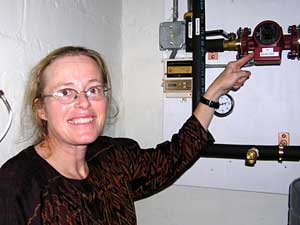 |
| Christine Ziebold points to a thermostat in her basement that records the temperature of the solar hot water tank used to heat her home. It registers 180 degrees Farenheit. (MPR Photo/Lorna Benson) |
St. Paul, Minn. — If you haven't followed advances in solar technology you might think solar power is just for powering lights, hairdryers, refrigerators or computers, or other appliances that run on electricity. But solar power can also heat a home during a cold Minnesota winter. Basically this method uses the sun to heat water which then heats a house.
It's called solar thermal power.
Typically solar needs some backup help to warm an entire home, especially during January and February. The standard rule of thumb is that solar thermal energy can provide between 30 to 40 percent of a home's heat while natural gas or some other heat source provides the rest. But even a 30-percent gain from solar is significant for some homeowners.
"This is the baby. 450 gallons," says Christine Ziebold, as she pats the side of a huge plywood and polyurethane container in her basement.
The container is filled with water that has been heating up all summer long, so it can be used to heat her house this winter.
Her husband, John Carpenter, points to a thermostat on the wall that registers the temperature inside the tank at 180 degrees.
"That's 450 gallons of water at 180 degrees, and that's actually thermostated to stop there, because otherwise we would end up boiling the thing. That's how hot the collectors actually get," says Carpenter.
The collectors are solar panels that are mounted on the roof. There are eight of them, and each one contains a coil filled with liquid. As the sun heats the liquid each day, it circulates through the coil and flows through a tube into the basement water tank. The tank then transfers its heat through another coil to a blower on the furnace.
Christine Ziebold says she installed her solar thermal system primarily to reduce her contribution to polluting greenhouse gases. But she readily admits that it will be nice to save money too. Ziebold says she's actually looking forward to getting her heating bills this winter.
"We want to see what's happening, especially given the fact that the gas bills are going to increase," she says.
Ziebold and Carpenter bought their solar thermal system from Innovative Power Systems. The Minneapolis company has installed most of the solar projects in the Twin Cities.
Owner Ralph Jacobson still works with solar electricity. But solar electricity jobs are quickly taking a back seat to Jacobson's solar thermal projects. He says the sudden demand for solar heating has changed his business dramatically, and is keeping him busier than ever.
"I think a number of people have been responding to the news about higher natural gas prices. And where maybe two years ago we were doing almost no solar heating, now I would say it's gone from a very small amount of our business to maybe 80 percent of our business," Jacobson says.
One of the things that he says is so appealing about a solar thermal heating system is that it's quite a bit cheaper to buy than a solar electrical system. Jacobson says the heating projects he installs cost on average about $15,000, compared to a range of between $15,000-$35,000 for solar electric.
Electric projects are not only more expensive to install, it also takes much longer for them to pay for themselves, since electricity is relatively inexpensive to buy at 11 cents per kilowatt hour. At that rate, the Minnesota Commerce Department estimates that it could take anywhere from 15 to 50 years to break even on a solar electric project.
But natural gas and fuel oil are not cheap these days, so it takes much less time to break even on solar thermal heating. Jacobson says some of his clients should be able to recoup their investment in as little as five years.
"My back of the envelope calculation is per dollar spent, you would get about eight times as much energy from a solar heating system as opposed to a solar electric system," says Jacobson.
Chris Born, a solar electricity user whose property is on this weekend's tour, spent $35,000 to put 22 solar panels on his garage. He doesn't use solar to heat his home, but he wishes now he had installed solar thermal heating.
"If I had it to over again that's what I'd do with this garage, but so it goes," he says.
Born doesn't have the extra money to do a solar heating project right now, but he is preparing for the day when he can do it.
He recently bought six hot water collectors that had been used to heat a swimming pool. He hopes to put them on his roof next year to heat his hot water heater and a small part of his house.
Born says he wouldn't have been able to install his existing solar system without the rebates that he received from the state and Xcel Energy. The rebates pay around $2,000 per kilowatt. Born received the maximum rebate of $8,000 for his project.
"The rebate is what really made it happen for us," says Born. "If we didn't have the rebate we wouldn't have done it. I know that. It just would have been a dream."
Minnesota lawmakers this year renewed the rebate program and extended it to other forms of solar power, including solar thermal heating. There's no state sales tax for solar energy systems. There is also a 30 percent federal tax credit.
David Boyce, president of the Minnesota Renewable Energy Society, says the rebates are a big incentive. But Boyce says that even if they weren't available, Minnesotans could still justify spending money on solar thermal energy.
"Regardless of what the government does or doesn't do, people see these things, people understand what's happening, people know that the gas is going to run out and before it does it's going to get really expensive," says Boyce. "They know all these other things are going to have to end someday, and this stuff is now affordable for a lot of people and it makes sense."
There are only 31 homes and businesses on this year's solar tour, which is indicative of the fact that solar energy is still just a tiny portion of Minnesota's overall energy supply. It's too soon to predict whether the sudden interest in solar heating will actually translate into a big jump in the number of solar-powered homes and businesses in the state.









